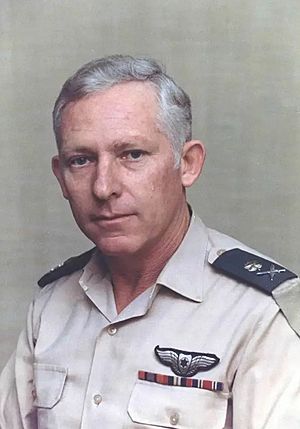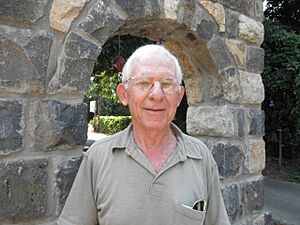Amos Lapidot facts for kids
Quick facts for kids
Amos Lapidot
|
|
|---|---|
 |
|
| Born | 1934 Kfar Saba, Mandatory Palestine (now Israel) |
| Died | (aged 85) |
| Allegiance | |
| Years of service | 1952–1987 |
| Rank | Aluf |
| Commands held | 113 Squadron, Hatzor Airbase, Air Intelligence Directorate, Commander of the Israeli Air Force |
| Battles/wars | Suez Crisis Six-Day War War of Attrition Yom Kippur War 1982 Lebanon War South Lebanon conflict |
| Other work | President of Technion – Israel Institute of Technology, Chair of the academic committee of the Fisher Institute for Air and Space Strategic Studies |
Aluf Amos Lapidot (1934 – November 20, 2019) was a brave Israeli fighter pilot. He became the tenth Commander of the Israeli Air Force (IAF), serving from 1982 to 1987. Later, he was the President of Technion – Israel Institute of Technology from 1998 to 2001.
Contents
Amos Lapidot's Early Life and Military Career
Amos Lapidot was born in Kfar Saba, Israel, in 1934. He grew up in a place called Havatzelet HaSharon. When he was young, he first joined the Artillery Corps of the Israeli army.
Joining the Israeli Air Force
Soon after, he decided to join the new Israeli Air Force (IAF). He finished his pilot training in 1954. As a pilot, he flew several types of airplanes. These included the P-51 Mustang, the Gloster Meteor, and the Dassault Ouragan.
Education and Advanced Studies
Amos Lapidot was also very smart in school. He earned a degree in mathematics from Tel Aviv University. Later, he studied at Stanford University in the United States. There, he earned a master's degree in financial systems engineering. This showed he was good with numbers and planning.
Lapidot's Role in Major Conflicts
Amos Lapidot played important roles in several wars. He was a key figure in the development and strength of the Israeli Air Force.
Flying in the Suez Crisis
During the Suez Crisis in 1956, he flew Ouragan and Dassault Mystère planes. These were important early fighter jets.
Leading Fighter Squadrons
In 1961, he started flying the Dassault Mirage III. This was a very advanced fighter jet at the time. He became the deputy commander of 101 Squadron. This was the very first squadron in the IAF to use Mirage jets.
A year later, in 1962, he took command of 113 Squadron. This squadron flew Ouragan planes. By 1965, he was back leading 101 Squadron. He led this squadron during the Six-Day War in 1967.
Commanding Hatzor Airbase
In 1970, he was put in charge of the weapons department for the Israeli Air Force. Then, in 1973, he became the commander of Hatzor Airbase. He led this important airbase during the Yom Kippur War.
Becoming Commander of the Israeli Air Force
Amos Lapidot continued to rise through the ranks. His leadership skills were recognized.
Leading Air Intelligence
In 1975, he was given the important job of leading the Air Intelligence Directorate. This group gathers and analyzes information about other air forces. In 1981, he became the director of the IAI Lavi project. This was a big project to build a new Israeli fighter jet.
Top Commander of the IAF
In 1982, Amos Lapidot was promoted to the rank of Aluf, which is like a major general. He then became the Commander of the Israeli Air Force. This was a very high and important position.
Key Achievements as Commander
During his time as commander, the Israeli Air Force received more F-16 fighter jets. These are powerful and fast aircraft. The IAF also improved its missiles, adding the Israeli AGM-142 Have Nap.
One famous mission during his command was Operation Wooden Leg. In this operation, the IAF flew 1,500 miles to Tunisia. They attacked the headquarters of the Palestine Liberation Organization (PLO). This showed the IAF's ability to strike targets far away. In 1987, Lapidot finished his term as Commander of the Israeli Air Force. He handed over command to Avihu Ben-Nun.
Life After the Air Force
After leaving the military, Amos Lapidot continued to contribute to Israel.
Academic and Public Service Roles
In 1988, he started a "think-tank" organization. This group worked on new ideas and strategies. From 1998 to 2001, he served as the President of Technion – Israel Institute of Technology. This is a very famous science and technology university in Israel.
In 2007, he led a public committee. This committee looked into ways to make aviation safer. He also chaired the academic committee of the Fisher Institute for Air and Space Strategic Studies. This institute studies important topics about air and space.


